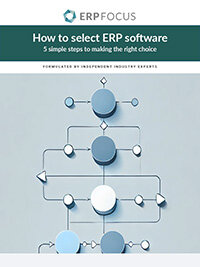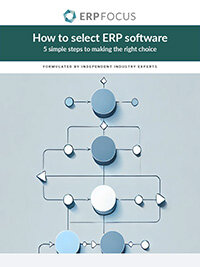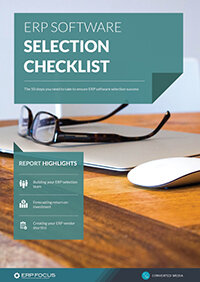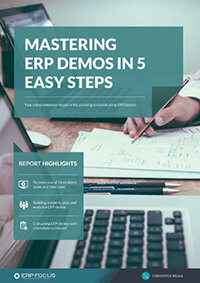Five steps to selecting the perfect open source ERP
While most enterprise folks turn to commercial ERP platforms first when it comes to selecting new software, there is another way to go - an ‘open-source’, or ‘freeware’ software license. This means that the system in question is typically delivered free-of-charge.
There are, however, also a number of things to be aware of when selecting open source ERP. We’ll get to those in a minute, but first let’s take a look at what an ‘open-source’ system involves and how it operates.
What ‘open source ERP’ means
1. Free redistribution
An open source ERP license cannot restrict anyone from selling or giving away the software as a component of larger software distribution containing programs from several different sources. The license shall not require a royalty or other fee for such sale.
Get advice on open source ERP selection with our step-by step guide to ERP selection success
2. Source code
The program must include source code, and must allow distribution in source code as well as compiled form.
3. Derived works
The system’s license must allow modifications and derived works, and must allow them to be distributed under the same terms as the license of the original software.
4. Integrity of the author's source code
The license may restrict source-code from being distributed in modified form only if the license allows the distribution of "patch files" with the source code for the purpose of modifying the program at build.
5. No discrimination against persons or groups
The license must not discriminate against any person or group of persons.
6. No discrimination against fields of endeavor
The software license must not restrict anyone from making use of the program in a specific field of endeavor.
7. Distribution of license
Rights attached to the program must apply to all to whom the program is redistributed without the need for execution of an additional license by those parties.
8. License must not be specific to a product
The rights attached to the program must not depend on the program's being part of a particular software distribution.
9. License must not restrict other software
The license must not place restrictions on other software that is distributed along with the licensed software.
10. License must be technology-neutral
No provision of the license may be predicated on any individual technology or style of interface.”
Steps to selecting the right open source ERP for you
This product approach is entirely legitimate, and the propagation of this type of license is accepted globally. Nevertheless, like everything else in the techno-sphere, open source ERP requires the appropriate level of research. The following five focus areas are a good place to start:
1. Ensure that you discuss the potential of selecting an ‘open-source’ system with senior management
Many senior enterprise managers consider freeware to be a risky proposition, since hard-nosed business people tend to believe that ‘you get what you pay for.’ As asserted earlier, there is nothing wrong with considering this type of system, but along with the typical ERP research you’ll also want to completely understand the aforementioned caveats in order make sure that everyone is on-board, since the effort will undoubtedly be a bit more rigorous than the norm.
2. Establish a set of comprehensive requirements
Again more is better in this case. You should not only understand your ERP requirements but also the stated functionality. In this case you may have to resort to looking at active demonstrations more closely and if you harbor an internal capability, take a look at the code base.
3. Ensure that mobility is part of the systems core capabilities
Many freeware developers deliver solid frameworks, but when it comes to more sophisticated elements, they tend to allow the user to do the heavy lifting. In this event, mobility will always be a core capability, so if the code base is not compliant operationally, pass and move on.
4. Ensure that security components are universal and easily applied
This concern equally applies to the previous discussion on mobility. Again, today’s freeware developers are savvy folks, but maybe they’d prefer that their ERP systems are ‘open enough’ to avoid any security entanglements. So, if you’re not happy with the systems central security elements; pass and move on.
5. Carefully research product reviews and user community comments
Experience is the best teacher, and this means that even though you may have gone through the previous set of hoops, the best thing before you pull the trigger is to ask other users for their takes on the system. This is particularly useful when it comes to mobility and security concerns, but in general the more you hear from others, the higher chance that what you actually want will be what you like in the end.
Free white paper

How to Select ERP
Learn to select your ERP in 5 easy steps by following our expert's advice

Featured white papers
-

ERP Software Pricing Guide
Get the latest pricing information on over 80 popular ERP systems, and learn how to budget for your ERP project in our free guide
Download -

60-Step ERP Selection Checklist
Get the comprehensive checklist for your ERP selection project
Download -

ERP Demo Guide & Scorecard
Master your ERP demo with 5 easy steps using our free guide (includes demo scorecard)
Download
Related articles
-

The best ERP systems for process manufacturing
Consider these ERP systems when selecting your next process manufacturing ERP
-

CMMC Compliance: What Aerospace and Defense Manufacturers Need to Know
Key insights on CMMC compliance, deadlines, and securing DoD contracts with CMMC 2.0 certificatio...
-

5 ERP pricing definitions you need to understand
Have you mastered the ERP pricing lexicon yet? Getting to grips with these five definitions is a ...

